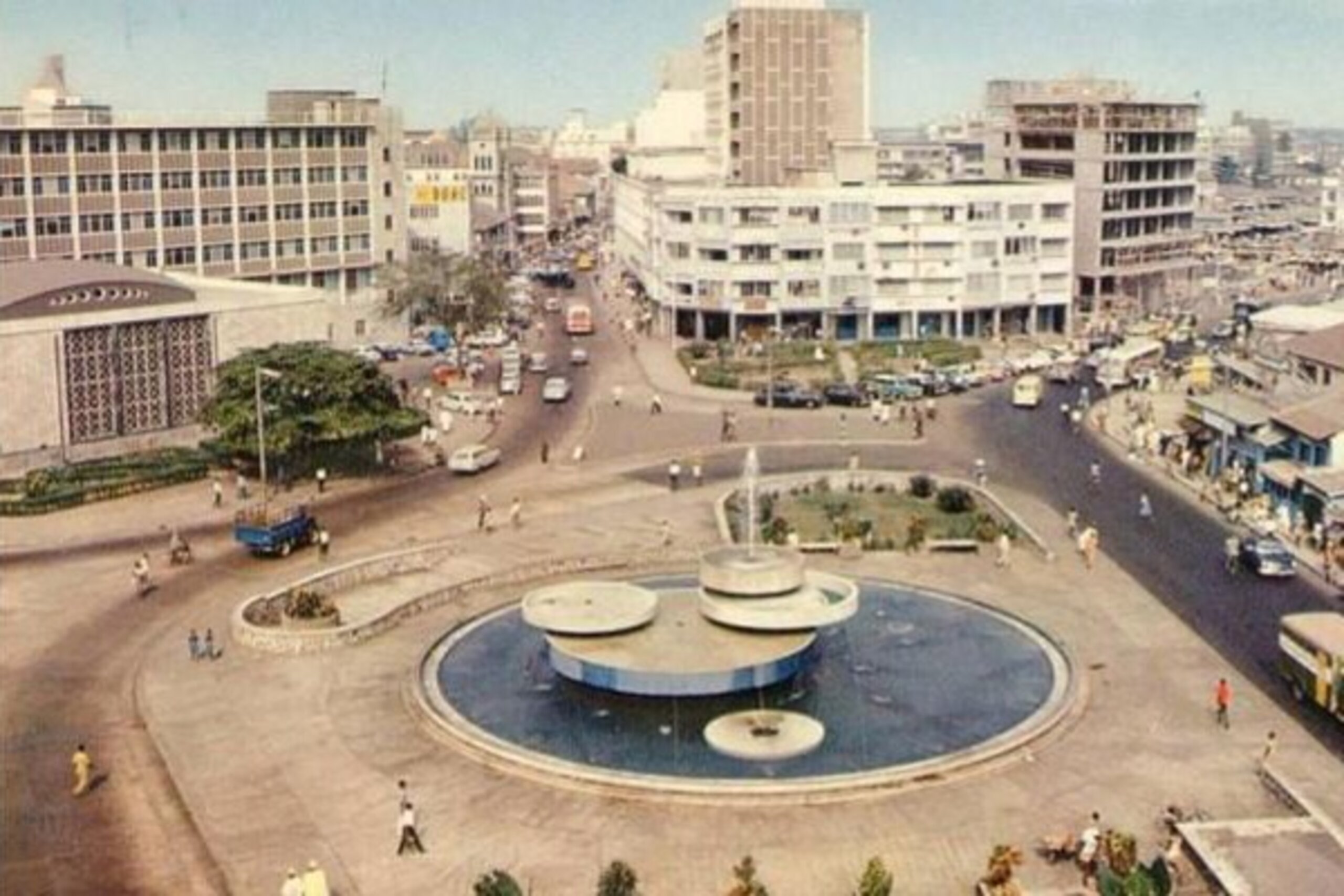Renaming Tinubu Square and why documentation is everything!

By Debo Adetula.
This is long so forgive me.
First off documentation matters a lot! It might seem mundane or tedious in the present but taking the time to invest in documenting events (in pictures and in writing) today yields incalculable dividends tomorrow.
Second, you’ll notice that most of the images in this post are tied together by Tinubu Square.
Colloquially known as Ita Tinubu, the area was redeveloped by the Lagos Executive Development Board at a cost of about 1 million GBP with a significant chunk going to slum clearance according to a 1962 publication I came across (Owen’s African and Middle East Commerce & Travel and International Register). The project reportedly started around 1956 and Ita Tinubu was officially named Independence Square. Sometime thereafter, it was renamed Tinubu Square however I’m unsure of the date and was unable to find concrete information ![]() – documentation matters a lot!
– documentation matters a lot!
Tinubu Square is a place with history as I alluded to in the preceding paragraph. I’ll touch on two aspects of the history of Tinubu Square in this write up
- The head-scratcher about why Madam Tinubu, a person with terrible antecedents is so lionized today (at least nationally since it is without question that she was an Egba hero)
- The corruption and misrepresentations that allowed for the 1958 demolition of the Henry Carr Mansion located at the Square.

The controversial Madam Tinubu
Efunroye Tinubu, introduced to many of us as Madam Tinubu in elementary Social Studies, was one of the preeminent indigenous slave traders in 19th century Lagos who said she’d rather let 20 of her enslaved people drown than sell them at a discount.
Tinubu and other indigenous slave traders were responsible for capturing, imprisoning, and then selling off enslaved Africans to Americas bound slave merchants. She and other last-mile human traffickers were the last black faces that victims of the slave trade from the hinterlands saw and were traumatized by. For more on this I recommend reading Samuel Ajayi Crowther’s narrative captured in Phillip Curtin’s Africa Remembered: Narratives by West Africans from the Era of the Slave Trade. Crowther seems to have handled the trauma well unlike one of his peers, Joseph Wright (an Egba) who was so traumatized by his experience that he refused to return to Lagos. Crowther and many others victims of the slave trade were rescued by the British Navy and resettled in Sierra Leone. Wright remained in Sierra Leone and said the below of Lagosians like Tinubu involved in the slave trade
“[They] are very cruel people. They would sell the children of their own bosom”Madam Tinubu was a savvy business woman whose heroic exploits defending Abeokuta from marauding Dahomey forces are well documented. Perhaps a monument to Tinubu’s honor ought to be located in Abeokuta but not in Lagos where she brought sorrow to many folks whose loved ones she sold off to slave merchants.To put things bluntly, Madam Tinubu was a gbomo-gbomo (Yoruba for kidnapper).Madam Tinubu was a force of nature in pre colonial Lagos with an army of enforcers she deployed to do her bidding. 4 different Obas of Lagos had to contend with this influential figure during their reigns and she reportedly had a romantic relationship with one of them (Oba Adele Ajosun).

Commentary on the complicity and involvement of the Obas of Lagos in the Slave Trade
A side note is that the Obas of Lagos from about the late 1700s till 1852 were neck-deep in human trafficking and got rich off the evil human trafficking trade. Lagos’ status as a Benin Kingdom backwater changed because of Lagos’ new found wealth that was propelled by human trafficking revenue.
Oba Akinsemoyin, in the late 1700s, granted slave trading monopolies to Brazilian and Portuguese slave merchants. Akinsemoyin and his heirs, as sovereigns, taxed every transaction and determined what slave merchants kept vs. what went into the Lagos coffers. So vast was the scale of the human trafficking operation in Lagos in the 1800s that Lagos overtook Ouidhah and Porto Novo to become the main slave trading port along the Bight of Benin.The revenue from human trafficking accruing to the Lagos coffers contributed to the unending Obaship of Lagos tussles from the early 1800s up until the climax of November 1851, when Lagos was invaded by the British Navy who backed Akitoye in his fight against Kosoko, Akitoye’s nephew who forced Akitoye from the throne back in 1845.Surprisingly, Kosoko delivered a resounding defeat to the British Navy in November of 1851. For context, as of the mid 1800s the British Navy was arguably the most powerful navy in the world. The British Navy returned in December 1851 to exact revenge for their November humiliation by Kosoko. After putting Kosoko to flight, the Brits restored Akitoye to the Lagos Obaship and both parties signed The January 1852 Treaty between Great Britain and Lagos abolishing the Slave Trade throughout Lagos.
Madam Tinubu subverts the Treaty abolishing human trafficking and conspires to assassinate the British Consul in Lagos
Madam Tinubu actively subverted the 1852 agreement because it blocked her flow of money from human trafficking. On two separate occasions (in 1855 and in 1856) she conspired to eliminate Benjamin Campbell, British Consul in Lagos. Tinubu was forced to leave Lagos by the authorities and her 1860 application for return to Lagos was refused.
Tinubu clashes with a young Lt Glover in Abeokuta, future Governor of Lagos and so begins an interesting relationship of mutual respect between the two
Tinubu continued her notoriety in Abeokuta where she clashed in 1859 with a young Lt. John Hawley Glover who had assembled a local Constabulary Force comprising men who were formerly enslaved and who found upward social mobility in Glover’s Force. This Constabulary formed the nucleus for the later Nigerian Police and Army.
Madam Tinubu and her army of enforcers confronted Glover and his Constabulary as they passed through Abeokuta on their way to Jebba to rescue the Dayspring Niger Expedition. Tinubu recognized one of the men in Glover’s Constabulary as one of her formerly enslaved men who had escaped and tried to retake him however Glover and the Constabulary dispersed Tinubu and her mob.
In a curious twist and in what probably endeared Glover to the indigenous power structure when he became Governor of Lagos (later in 1863 and until 1872), Glover diplomatically offered Madam Tinubu propitiatory gifts of cloth
Glover was a savvy Governor who took an unconventional approach to administering the new Crown Colony of Lagos. Glover actually arranged for Tinubu’s return to Lagos and I assume some type of political return was gained from that investment considering Glover’s documented political network that assisted his administration of Lagos.
Glover established a patronage network of Baba Isales who were loyal to him. He was fondly known by Lagosians as Oba Goloba. Madam Tinubu did not forget Glover’s overtures as she reportedly donated the land upon which Glover Memorial Hall was built.
Unsupported tale about Madam Tinubu’s renunciation of slavery
A fanciful tale exists about Madam Tinubu renouncing human trafficking however I’m yet to find any credible documentation about said renunciation. It is one I was indoctrinated with until I started to do more reading about the effects of the slave trade in Lagos.
Interestingly, a Madam Tinubu praise work (Madame Tinubu: Merchant and King-maker) by Oladipo Yemitan rubbishes this fanciful tale and acknowledges that during the latter period of her life, Tinubu was unapologetic about human trafficking.
Tinubu was brought before Ogundipe Alatise (who presided over Abeokuta) for kidnapping and selling a young boy into slavery and she responded thus: “I have a large house-hold and I must feed them well. I need money to do that, that’s why”– documentation matters a lot!

Bust of Madam Tinubu provided by Kayode Ogunfeibo 
Undated photo of Henry Rawlingson Carr, the Nigerian Director of Education in the British Colonial Service. 
“KEY to Mr. J.B. Lock’s ELEMENTARY TRIGONOMETRY by Henry Carr. B.A OF THE GRAMMAR SCHOOL LAGOS, WEST AFRICA”. This was the first book published in 1910 by Henry Carr, the brilliant Nigerian education administrator and architect behind the formation of King’s College Lagos. One author notes how Carr’s book “created some sensation in Mathematics circles in England” and caused “publishers to correct the errors in Wormall’s Arithmetic” 
The landmark Henry Carr mansion with the 18,000 book library. The mansion was designed by Herbert Macaulay. It was demolished in 1958 after misrepresentations about its structure were given in court to give way for Mosaic House, the former home of the Federal Ministry of Finance. Source: Sandbank City: Lagos at 150 by John Godwin and Gillian Hopwood 
Photo from Bimbola Babarinde showing Tinubu Square in the 1940s with a focus on the Henry Carr mansion. 
Old CBN buildings at Tinubu Square. These are the buildings featured on the old 50 kobo note. Source Unknown. 
January 1962 picture of Tinubu Square taken by Maarten van Dis. The fountains were gifted by the Lebanese Community to mark Nigeria’s Independence. Source: Maarten van Dis/ NSAG (Nederlands studenten Afrika Gezelschap) 
50 Kobo note depicting the CBN buildings at Tinubu Square. As a little boy, I thought this was one of the 1004 Housing Estate buildings
Monument naming discipline and criticism of Nigerian history custodians i.e. Ibadan School of History notables
People who monuments are named after reflect the values of the society that these monuments are located. Monument naming should be properly governed and informed by rigorous research, debate, and consultation.
I understand that after Nigeria’s independence, there was a nationalist movement that sought to lionize figures who took an anti-colonialist stance and presumably, this is how Madam Tinubu became a celebrated figure. A deeper study of Nigeria’s colonial history reveals that things were not so black and white so taking a simplistic approach that says “British bad therefore hero” misses the mark.
What does it say to the descendants of Africans all over the south, central, and north America that Nigeria memorializes a notorious and indigenous human traffickers and that we laundered her image with a fancy tale about how she renounced human trafficking?Indigenous custodians of Nigerian history such as Saburi Biobaku also deserve criticism for not properly documenting Tinubu’s human trafficking despite their proximity to material supporting her actions. Here’s Saburi Biobaku’s flippant summary of Madam Tinubu from Eminent Nigerians in the 19th Century“She may have traded in slaves as Consul Campbell alleged, but so did many of that era of transition toward legitimate commerce”
Alleged? Really?
The corruption and misrepresentation that allowed the destruction of the landmark Henry Carr mansion at Tinubu Square
Before discussing the dispiriting Carr mansion demolition, an overview of the landmark’s resident and owner is necessary.
Henry Rawlingson Carr – the uncelebrated education policy maker in southern Nigeria and the dominant spirit behind King’s College Lagos’ establishment
I briefly attended University of Lagos and was unaware that Henry Carr Hall was named after a Nigerian! I erroneously thought Henry Carr was a British colonialist until I happened upon an interesting comment thread about his feud with Herbert Macaulay in one of the older NNP threads from about a decade ago.
My interest was piqued by this Henry Carr man so I went down the rabbit hole of learning about this misunderstood and uncelebrated Nigerian who not only influenced education in Nigeria as Director of Education in the British Colonial Service but also was the chief advocate for the formation of King’s College Lagos (KC), the secondary school that I attended. This important historical nugget is not a part of the school’s history taught to students.
The British Colonial government was not in favor of KC’s establishment given the existence of storied institutions such as CMS Grammar School and Methodist Boys High School. Henry Carr’s advocacy silenced the voices in the colonial government. One historian notes the following about Carr’s remarkable KC advocacy.
“Carr suggested a purely optional religious instruction, lower fees than those earlier recommended by Egerton in 1907 and later Acting Governor, J. J. Thor-born who thought there was a strong tendency in Lagos to expect everything free or almost free of cost- a tendency to be discouraged. Moreover Carr recommended a large number of scholarships and maintenance allowances for the students; while those who proved very good academically should be sent overseas for higher training.”
There’s also a wrong narrative about Henry Carr that lives on presumably attributed to Herbert Macaulay’s mischief making and slander of Henry Carr. Macaulay used his newspaper to attack Carr and paint Carr as a British colonial stooge completely disconnected from everyday people.
I came across Henry Carr’s own words about the need for educational reforms in Calabar. Would a disconnected man be so pragmatic?
“I listened to a lesson in English History given by the principal teacher…It seemed to me that too much time was wasted on such abstract ideas as ‘civilization’, ‘education’, ‘art’, and ‘industry’, and too little attention given to concrete facts and positive information…it did not seem to me that the children took any intelligent interest in the history of the early British Kingdoms. If history should be taught at all, it should begin with the history of Old Calabar, the Protectorate and West Africa..The same lines should be followed in geography. The pupils should first be taught to observe what is round about them…the aim being to bring them into contact with nature and the life they have to live”.Inaccurate narratives must be challenged by facts – documentation matters a lot!
Carr’s background
Henry Rawlingson Carr was a brilliant man. His first degree was in Mathematics and Physical Sciences. He took on a law degree later in life to satisfy his intellectual thirst. His first publication in 1910 titled Key To Mr. J.B. Lock’s Elementary Trigonometry, according to one author “created some sensation in Mathematics circles in England” and caused “publishers to correct the errors in Wormall’s Arithmetic”. Carr was introverted and took his Christian faith very seriously. He was married to Henriatta Robin and died in 1945.
The landmark Henry Carr mansion and its 18,000 book library
Henry Carr and Herbert Macaulay were friendly before things went south. Herbert Macaulay was the architect who designed the Carr mansion. The nature of how the feud between Macaulay and Carr started remains a gossipy topic since folks who could have set the record straight have since passed away. It seems no one properly documented how things degenerated between both men – documentation matters a lot!
In addition to its imposing structure, the Carr mansion was notable for its 18,000 book library that Carr opened up to neighborhood school children. Carr’s books were not just for decorative purposes as many historians noted that they contained Carr’s notes and markings, signs of his intellectual curiosity.When Carr died, the Nigerian government acquired his 18,000 book volume and sent them to University College Ibadan (now University of Ibadan), where they constituted a part of the foundation library at University College.
The Carr mansion’s scandalous demolition
The mansion was demolished in 1958 to make way for Mosaic House, a Federal Government building housing the Ministry of Finance and the Central Bank. The story behind the mansion’s destruction tells a sad story about corruption and misrepresentation.
John Godwin, a British architect and now naturalized Nigerian citizen who designed many buildings in Lagos recounted in his book (Sandbank City: Lagos At 150) how he, in 1955, refused to give false testimony in court to justify the building’s demolition. Unfortunately someone else testified that the mansion’s structures were in bad condition and the building was demolished. Very few pictures exist of the mansion so Nigerians today were denied access to a major landmark. Who was the unscrupulous person that provided false information in court? Had John Godwin not included this nugget in his book, we probably wouldn’t know about it because of poor documentation. Documentation matters a lot!
According to a 2013 article by The Nation, Mosaic House had been overrun by beer parlors, canteens, traders, and squatters, and this landmark demolition to obscure building trajectory is somewhat reminiscent of the fate of another historic Lagos landmark – Ajele Cemetery.
Ajele Cemetery was sacred ground and a historic site for more than a century before it was demolished by Brigadier Mobolaji Johnson’s Lagos State military government. More than a century of history was uprooted to make way for some government building that is of very little notability today.
Even more curious is the fact that Brigadier Johnson’s decision was made at a time when land was plentiful in Lagos. Johnson wrote no memoirs so his rationale for the demolition of Ajele Cemetery remains a mystery.
Documentation matters a lot!
- Debo Adetula is one of the curators of The Nigerian Nostalgia 1960 -1980 Project


